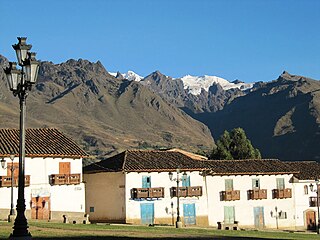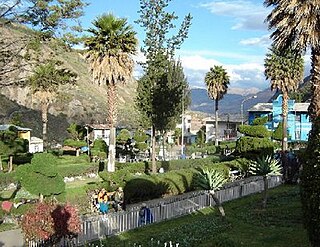
Quechua, also called Runa simi in Southern Quechua, is an indigenous language family that originated in central Peru and thereafter spread to other countries of the Andes. Derived from a common ancestral "Proto-Quechua" language, it is today the most widely spoken pre-Columbian language family of the Americas, with the number of speakers estimated at 8–10 million speakers in 2004, and just under 7 million from the most recent census data available up to 2011. Approximately 13.9% of Peruvians speak a Quechua language.

Ancash is a department and region in western Peru. It is bordered by the departments of La Libertad on the north, Huánuco and Pasco on the east, Lima on the south, and the Pacific Ocean on the west. Its capital is the city of Huaraz, and its largest city and port is Chimbote. The name of the region originates from the Quechua word anqash, from anqas ('blue') or from anka ('eagle').

Aymara is an Aymaran language spoken by the Aymara people of the Bolivian Andes. It is one of only a handful of Native American languages with over one million speakers. Aymara, along with Spanish and Quechua, is an official language in Bolivia and Peru. It is also spoken, to a much lesser extent, by some communities in northern Chile, where it is a recognized minority language.

Kichwa is a Quechuan language that includes all Quechua varieties of Ecuador and Colombia (Inga), as well as extensions into Peru. It has an estimated half million speakers.

Southern Quechua, or simply Quechua, is the most widely spoken of the major regional groupings of mutually intelligible dialects within the Quechua language family, with about 6.9 million speakers. Besides Guaraní it is the only indigenous language of America with more than 5 million speakers. The term Southern Quechua refers to the Quechuan varieties spoken in regions of the Andes south of a line roughly east–west between the cities of Huancayo and Huancavelica in central Peru. It includes the Quechua varieties spoken in the regions of Ayacucho, Cusco and Puno in Peru, in much of Bolivia and parts of north-west Argentina. The most widely spoken varieties are Cusco, Ayacucho, Puno (Collao), and South Bolivian.
Wanka Quechua is a Quechuan language, spoken in the southern part of Peruvian region of Junín by the Wanka people.

Spanish is the de facto official and administrative language of Chile. It is spoken by 99.3% of the population in the form of Chilean Spanish, as well as Andean Spanish. Spanish in Chile is also referred to as "castellano". Although an officially recognized Hispanic language does not exist at the governmental level, the Constitution itself, as well as all official documents, are written in this language.

San Martín de Chacas is a Peruvian town, capital of the eponymous district and the Asunción Province, located in the east-central region of Ancash. It has an urban population of 2,082 located at 3,359 meters; and a district of 5,334 people. The district, located in the sub-basin of the Marañon River, has an area of 447.69 km2, which represents 85% of the province.

The Sihuas Province is one of twenty provinces of the Ancash Region in Peru.This province was created by Law nº 13485, dated at January 9 of 1961, when was president of Perou: Manuel Prado. It is bordered by provinces of Huaylas and Corongo on the west, Pallasca Province on the north, La Libertad Region on the east, and Pomabamba Province on the south.

The languages of South America can be divided into three broad groups:
Pacaraos Quechua is a variety of Quechua spoken until the middle of the 20th century in the community of Pacaraos in the Peruvian Lima Region in the Chancay valley up to 3000 m above sea level.
Cajamarca Quechua is a variety of Quechua spoken in the districts of Chetilla, Baños del Inca and Cajamarca (Porcón) in the Peruvian province of Cajamarca, along the northwest coast of Peru.
Yaru Quechua is a dialect cluster of Quechua, spoken in the Peruvian provinces of Pasco and Daniel Alcides Carrión and neighboring areas in northern Junín and Lima department.

Quechua I, also known as Quechua Wáywash, or Quechua B, is one of the two branches or genealogical groups of the Quechua languages. It is composed of a great diversity of linguistic varieties distributed in the mountains of central Peru, in the departments of Ancash, Huánuco, Pasco, Junín and Lima. This Quechua I differs from the Quechua II by the use of long vowels and in several morphemes. According to the linguists Torero and Carranza, they are older than Quechua II.
Challhuacocha is a lake in Peru located in the Ancash Region, Pallasca Province, Conchucos District. It lies southeast of Lake Pelagatos, northwest of the lake named Labrascocha (possibly from Quechua Lawrasqucha) and north of the village of Challuacocha (possibly from Quechua Challwaqucha). It is situated at a height of 3,878 m (12,723 ft) comprising an area of 0.460868 km2 (460,868 m2).
Lake Llamacocha is a lake in the Andes of Peru. It is located in the Ancash Region, Pallasca Province, Conchucos District, northeast of Conchucos. It is situated at an elevation of 3,501 m (11,486 ft) comprising an area of 0.041169 km2 (41,169 m2).
Quinuacocha is a lake in Peru located in the Ancash Region, Pallasca Province, Conchucos District. It is situated at a height of 4,218 m (13,839 ft) comprising an area of 0.381966 km2 (381,966 m2). Quinuacocha lies northeast of a group of lakes named Pusaccocha.
Pariacocha is a lake in the Andes of Peru. It is situated at a height of 4,250 m (13,940 ft) comprising an area of 0.025258 km2 (25,258 m2). Paryaqucha is located in the Ancash Region, Pallasca Province, Conchucos District, northwest of Quinuacocha.
Wayq'uqucha is a lake in the Andes of Peru. It is situated at a height of 3,997 m (13,114 ft) comprising an area of 0.11571540 km2 (115,715.40 m2). Wayq'uqucha is located in the Ancash Region, Pallasca Province, Conchucos District.

Huaylas Quechua is an Ancash Quechua dialect spoken in the Callejón de Huaylas and in the western slope of the Cordillera Negra.











